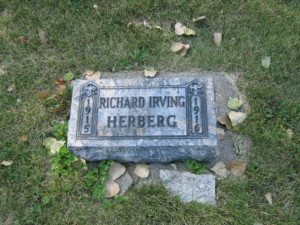
Richard Herberg was the four-month-old son of Frederick Axel and Caroline Herberg and the twin of brother Russell. Their family lived at 3209 24th Avenue. Richard is buried in Lot 24, Block N.
By Sue Hunter Weir
Era causes of death reflect medical knowledge
Richard Herberg”'s death certificate lists his cause of death as “dentition.” By the time that he died in April 1916, dentition was rarely recorded as a cause of death. It was an old-fashioned medical term and one that had been called into question as a “real” disease. That was not always the case.
A baby boy, known only as C. M. Miller, was thought to have died from “teething and flow” in 1864. “Teething” as a cause of death had a long, though not, as it turns out, very accurate history. Hippocrates referred to it in his writings almost 2,500 years ago and the medical community didn”'t change its thinking on the subject until some time in the late 1870s or early 1880s. Cemetery records list teething or dentition as a cause of death several times in the 1860s and early 1870s but only three times after 1885.
There are 19 infants in the cemetery who were thought to have died from teething. Another ten died from “dentition,” a more scientific-sounding name for the same thing. Those 29 children had several things in common””their ages ranged from four months to a little under two years old, the age when children are, in fact, teething. One other thing that is shared by many, though not by all of the children, is the time of year in which they died. Eighteen of the 29 children (62%) died in mid-to-late summer (July, August or September).
Modern-day medical historians who have looked at the high rate of teething deaths in the mid-to-late nineteenth century believe that teething was not really a cause of death at all and regard it as a “questionable diagnosis.” They believe that the children died from some other cause and the fact that they were teething at the time was merely a coincidence.
A more likely cause was something that at the time was called “cholera infantum,” another now-outdated medical term. In the nineteenth century cholera infantum was one of the most commonly reported causes of death for children under the age of two. There are over 900 infants who died from cholera infantum or, sometimes, though less commonly, called “summer complaint” buried in the cemetery; more than 780 of them (86%) died during July, August and September. Cholera infantum is thought to have been a bacterial infection caused by poor sanitation or contaminated food and water, and those deaths occurred at a time when Minneapolis did not have a municipal water supply and any way of refrigerating their food.
So it was somewhat unusual for dentition to be listed as a cause of death as late as 1916. Medical thinking had changed by then, but not all doctors would necessarily have known about or accepted that change. It may be that the doctor used the term simply because he wasn”'t sure why Richard had died.
What we know about Richard is that he was the four-month-old son of Frederick Axel and Caroline Herberg. Richard was born on November 18, 1915, and had a twin brother, Russell. His parents were immigrants””his father from Sweden, his mother from Norway. Frederick and Caroline married on May 6, 1911. Richard and Russell were their first-born children. Their daughter Bernice was born in 1917 and their son Wallace was born in 1920. The family lived near the cemetery, at 3209 24th Avenue South, for many years. Frederick worked as a teamster. Russell, Richard”'s twin, lived to be 73.










So interesting. Thank you for your article.